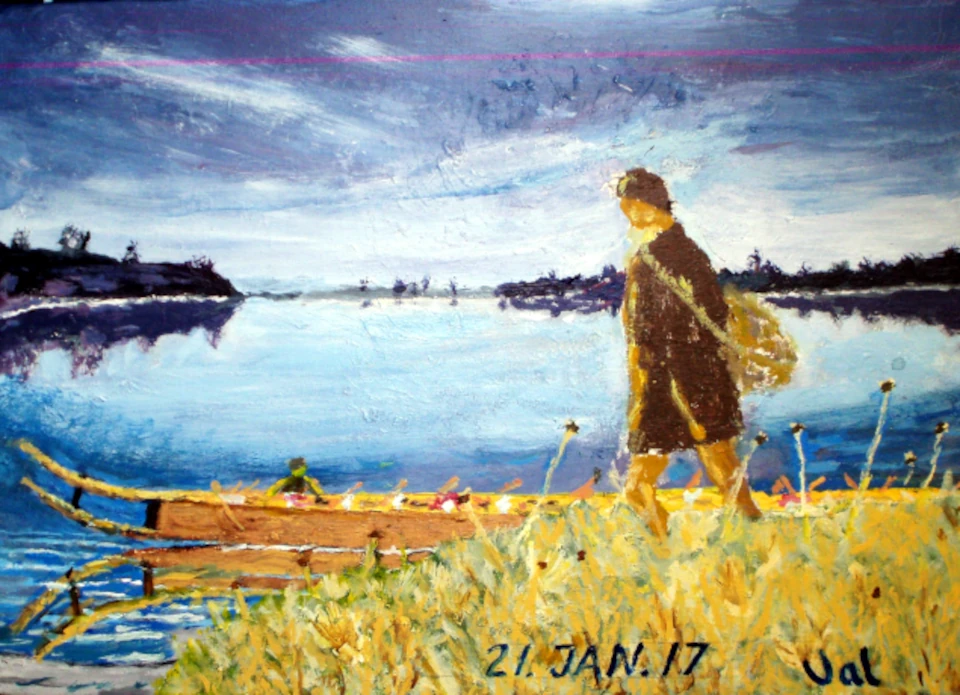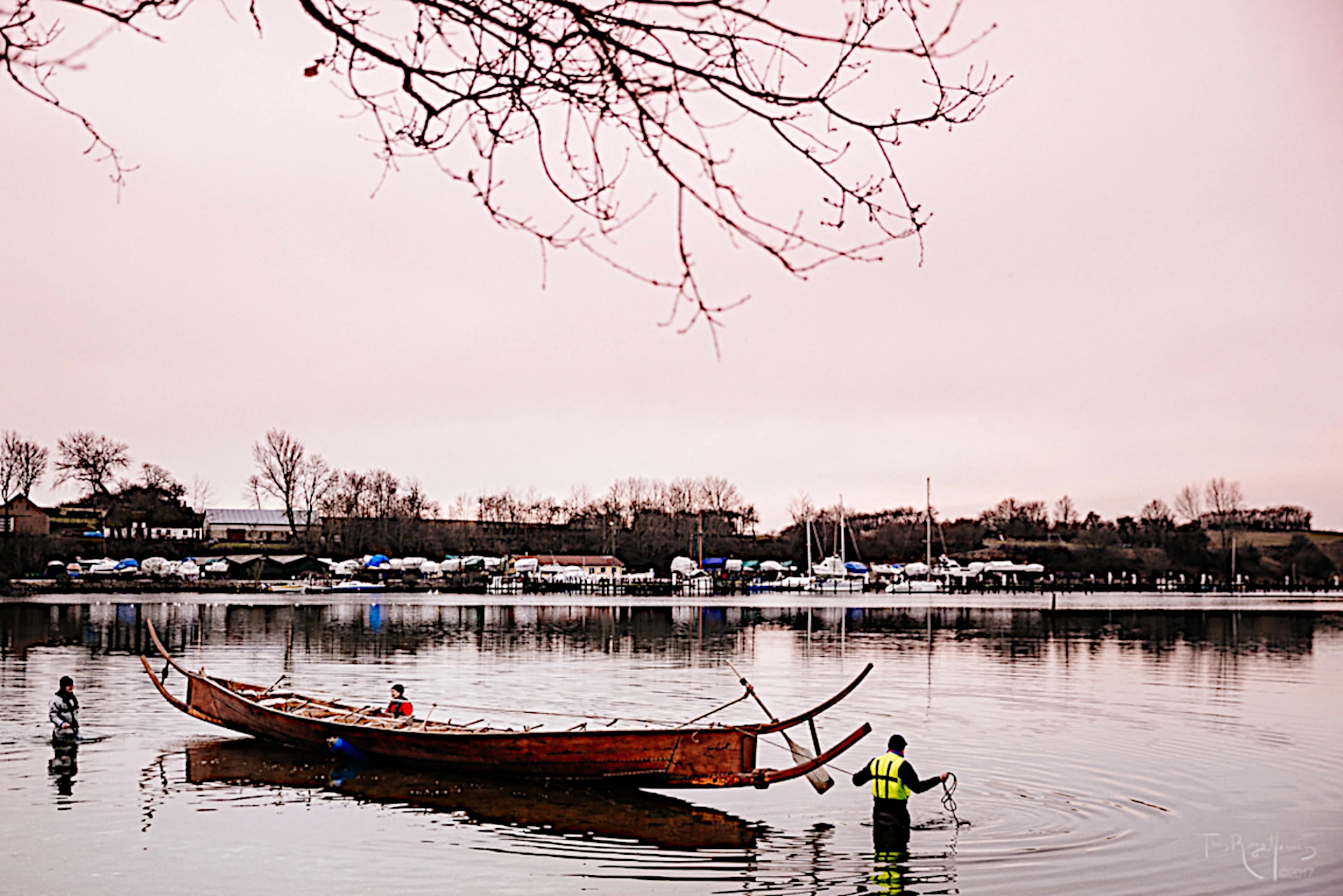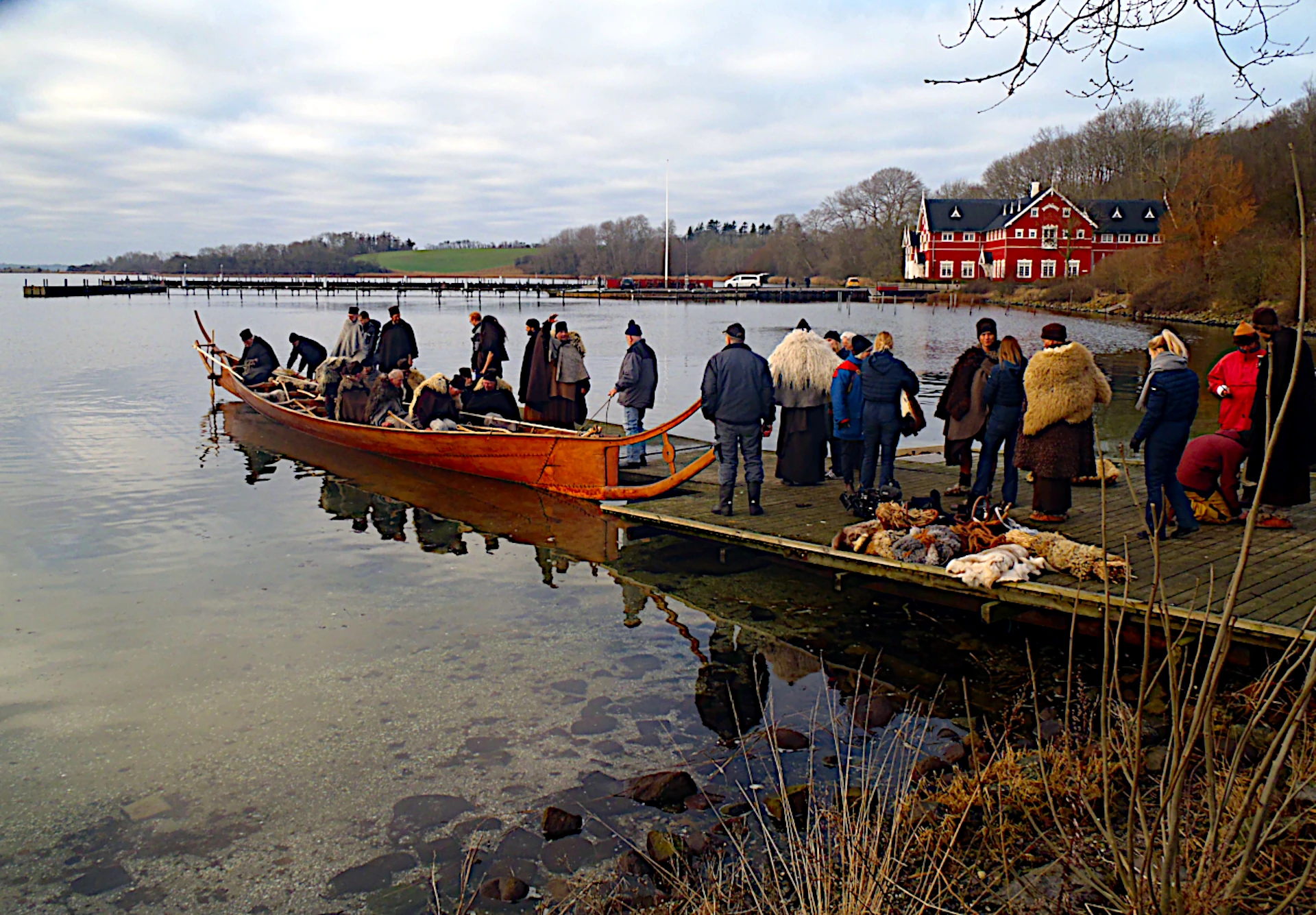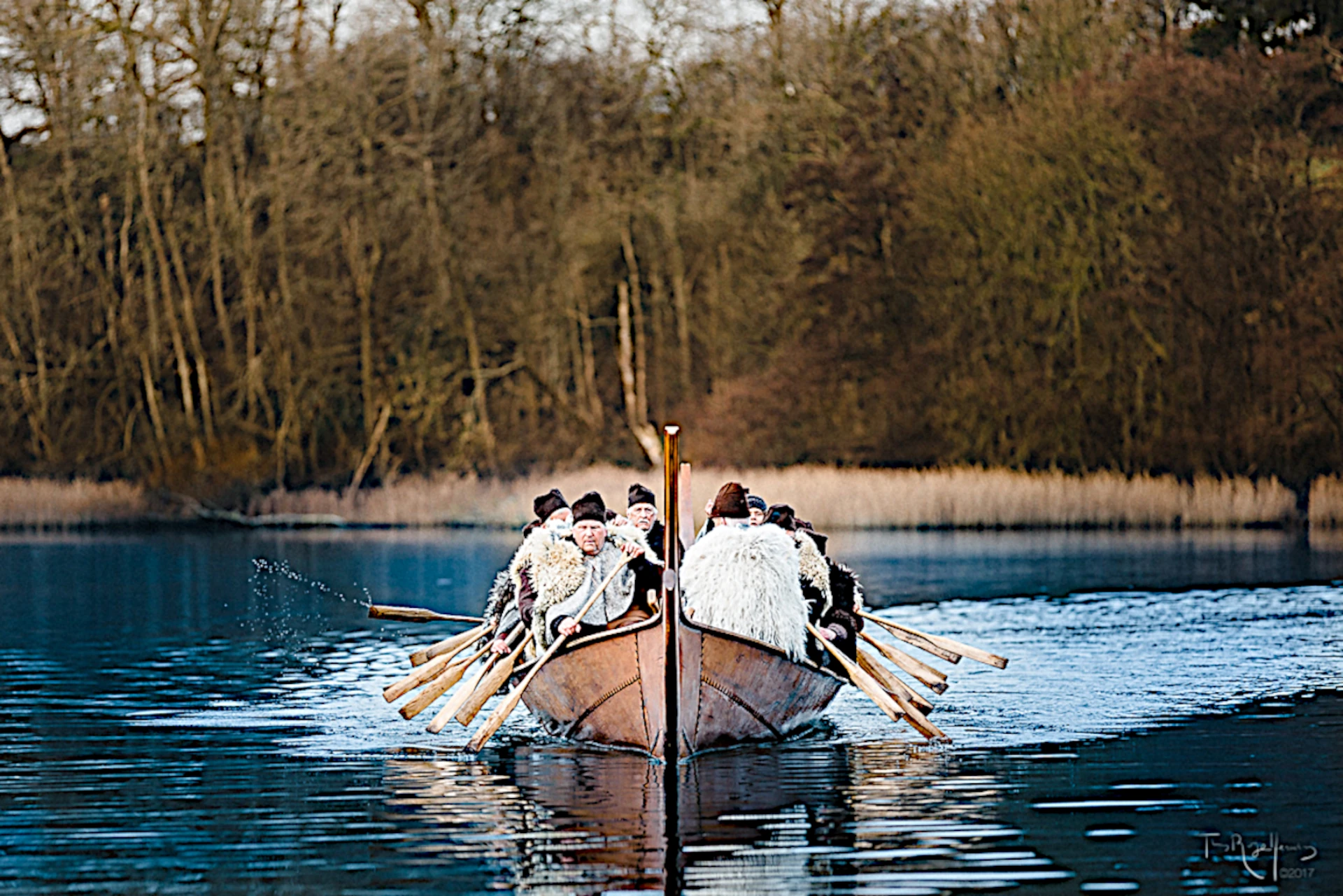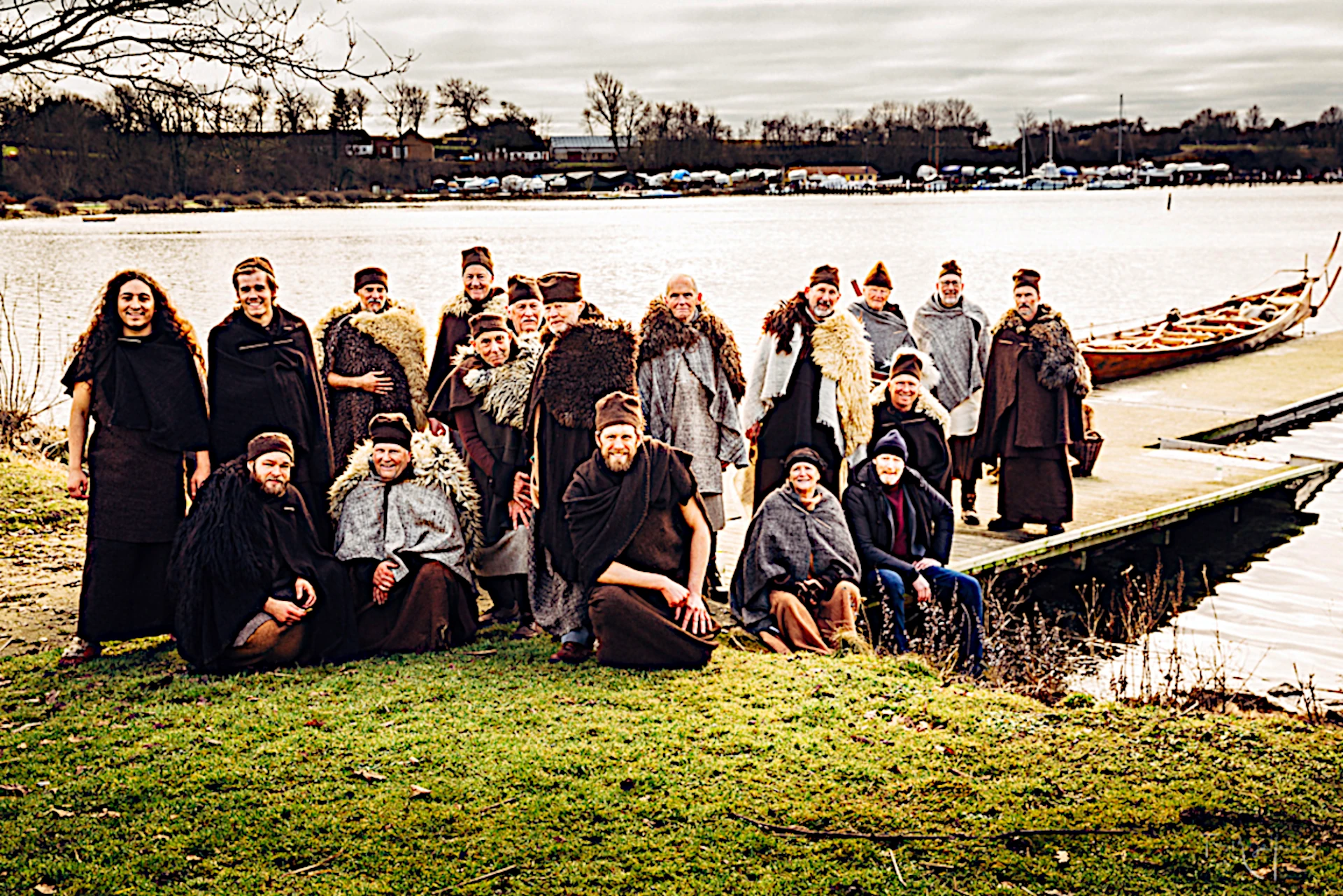21 January 2017
Here I am, on 21 January 2018, looking out over Dyvig, sunny and windless. The water reflects the wooded slopes that surround the cove and I think back to the year before, 21 January 2017, the day when we, the Hjortspring Boat Guild, together with Danmarks Radio, participated in the recording of some features in ‘The History of Denmark, the Age of Metal’. The weather was similar that day, a favourable situation for sailing in the cold water. And cold it was, both in the water and in the air.
Preparations
The cold brings us back to the months before, when DR approached us to propose that we participate in some sailing events filming for the above-mentioned series of programmes. At first the guild rejected the proposal, it was too cold and consequently too dangerous (in case of a capsize). However, we decided to contact DR again, as it was a unique opportunity to profile our guild and boat. In December, a contract was drawn up with DR with a number of reservations, the plan was that the sailing would take place on 7 January, or alternatively on 21 January, depending on the weather, or not at all. A few days before 7 January, a few members met to assess the situation. There was a thin layer of ice over large parts of the bay, so we had to cancel the sailing.
Both before and after 7 January, a number of meetings were held at the Linde shipyard, where many concerns were aired, more or less relevant. The result, however, was that the project had to include a number of reservations, especially regarding the cladding, lifeboat and sail plan (water depth not exceeding 1 metre).
A few days before 21 January, the weather forecast showed ideal weather, both wind and temperature, so we informed DR about the possibility of going ahead on the 21st.
The day before, late afternoon, the cortege, which you can almost name the number of cars, arrived with photographers, instructor, dressers and whatnot.
After a brief introduction at the Linde shipyard, we drove down to Dyvig, looked at the conditions of the water, the bridge and Deutsche Ruderverein Norderhardes clubhouse, which the rowing club had made available for clothing etc.
A few days before 21 January, the weather forecast showed ideal weather, both wind and temperature, so we informed DR about the possibility of going ahead on the 21st.
The day before, late afternoon, the cortege, which you can almost name the number of cars, arrived with photographers, instructor, dressers and whatnot.
After a brief introduction at the Linde shipyard, we drove down to Dyvig, looked at the conditions of the water, the bridge and Deutsche Ruderverein Norderhardes clubhouse, which the rowing club had made available for clothing etc.
Sailing day
Those of us who had signed up for the activity, 16 crew members, a number of ‘bulwark sailors’, excuse the expression, and later some members who would take care of the catering, a planned dinner at Lindeværftet to end the day, met up partly at Lindeværftet to bring Tilia down to Dyvig and partly at the rowing club to get dressed.
The outfits were ready and within a few hours, the crew members were unrecognisable with peasant's coats, furs, hats and make-up.
Tilia had arrived, she was launched and towed to the rowing club bridge by some members of the kayak club.
The outfits were ready and within a few hours, the crew members were unrecognisable with peasant's coats, furs, hats and make-up.
Tilia had arrived, she was launched and towed to the rowing club bridge by some members of the kayak club.
Lars Mikkelsen, the commentator throughout the ‘History of Denmark’ series, had also turned up, interested in everything around him and very chatty while the preparations took place.
The first sailing started around 10:30, the purpose was to film the boat from the outside. In addition to the 16 guild members, there were 4 extras hired by DR. The photographer travelled in the fire brigade's lifeboat. In view of the many concerns, I, as the corresponding shipowner, had to tell the captain that the voyage could only take place along the east coast of Dyvig, in shallow water. We took a trip there back and forth, the water was clear and the wind near zero, the stability was convincingly good. Based on this, the captain steered Tilia across the bay to the area west of the beach hotel, a much more suitable place to film due to the undeveloped background. A good choice and consistent with a captain's authority once a ship had cast off (I was there, not as a ship owner, but as a drummer).
The first sailing started around 10:30, the purpose was to film the boat from the outside. In addition to the 16 guild members, there were 4 extras hired by DR. The photographer travelled in the fire brigade's lifeboat. In view of the many concerns, I, as the corresponding shipowner, had to tell the captain that the voyage could only take place along the east coast of Dyvig, in shallow water. We took a trip there back and forth, the water was clear and the wind near zero, the stability was convincingly good. Based on this, the captain steered Tilia across the bay to the area west of the beach hotel, a much more suitable place to film due to the undeveloped background. A good choice and consistent with a captain's authority once a ship had cast off (I was there, not as a ship owner, but as a drummer).
After an hour of sailing (without freezing) we landed and had a bowl of good soup (I don't know what it was, but it tasted good and it was hot).
After the break we boarded again, this time with Lars Mikkelsen, a photographer and a sound engineer. Once again we sailed west of the seaside hotel and a number of inboard films were recorded with accompanying Lars Mikkelsen comments.
After the break we boarded again, this time with Lars Mikkelsen, a photographer and a sound engineer. Once again we sailed west of the seaside hotel and a number of inboard films were recorded with accompanying Lars Mikkelsen comments.
After an hour's sailing, we landed at the bridge, where Tilia was unloaded of its large quantities of furs and other equipment. The crew was lined up for a photo shoot.
The boat was taken to the pick-up point, put on the trailer and rolled up to the Linde shipyard. Lars Mikkelsen actively participated in these activities.
At the Linde yard, a meal was laid out, we had arranged an excellent skipper labskovs and the DR people had also organised a cold table (just in case, they didn't know if the natives' food was edible). Our food was now a success, several people wanted the recipe.
It was a good day
Knud V. Valbjørn.
Sources
- Newsletter, April 2017, no. 2.
- Danish Broadcasting Corporation,
History & Faith:
Historien om Danmark. (Google link, the series is available from DR for study purposes) - Newsletter, February 2018, no. 1.
Language
The text in this article has been translated from Danish to English using the free DeepL translation programme.




